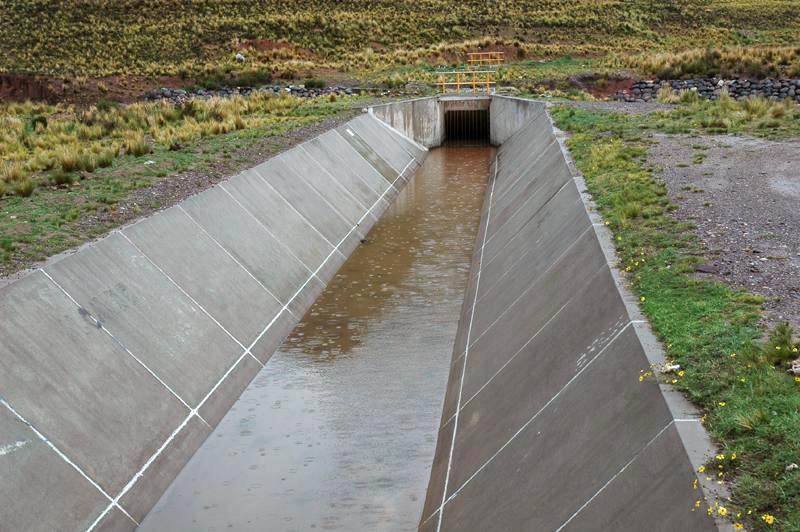
|
| Fig. 1 Irrigation canal downstream of siphon, Cabana-Mañazo, Puno, Peru. |
Victor M. Ponce
Professor of Civil Engineering
San Diego State University
[091029]
ABSTRACTThe Reynolds number is revisited to add the energy slope to the expression for the macroviscosity. The modified Reynolds number is judged to be conceptually better than the traditional number, which is independent of the energy slope.
• INTRODUCTION •
The Reynolds number is a dimensionless number expressed as (Chow, 1959):
| Re = ρVL / μ | (1) |
in which ρ = mass density of the fluid, V = flow velocity, L = a characteristic length, and μ = dynamic viscosity, a function of fluid type and temperature.
The conventional interpretation of the Reynolds number is that it is a ratio of inertial to viscous forces (or stresses). The inertial stress is represented as:
| τi ∝ ρV2 | (2) |
More properly though, Eq. 2 is an expression not of an inertial stress, which arises under unsteady flow, but rather of a steady external frictional stress. In fact, Eq. 2 is an expression for the quadratic law of (external) friction.
Drawing on Newton's law of viscosity, the viscous (or internal) stress is (Chow, 1959):
| &tauv ∝ μV / L | (3) |
Thus, it follows that Eq. 1 is properly a ratio of external to internal stresses.
By recasting the Reynolds number as a ratio of fluid macroviscosity to microviscosity, an improved formulation can be obtained. These propositions are now substantiated.
• THE REYNOLDS NUMBER •
The Reynolds number (Eq. 1) can also be expressed in terms of kinematic viscosity (ν):
| Re = VL / ν | (4) |
The parameter L is a characteristic length. In closed-conduit flow, L is interpreted as the pipe diameter D, such that:
| Re = VD / ν | (5) |
In open-channel flow, L is interpreted as the hydraulic radius R. Thus, the Reynolds number is:
| Re = VR / ν | (6) |
For a circular pipe: R = D/4. Therefore, the Reynolds number for pipe flow in terms of hydraulic radius is:
| Re = 4VR / ν | (7) |
Equations 5 to 7 have been in common use for nearly a century. There is an implicit understanding of the Reynolds number as a ratio of viscosities. The numerator is effectively a macroviscosity, a function of the bulk fluid properties. The denominator is the fluid's microviscosity or internal viscosity, a function of fluid type and temperature.
• MACROVISCOSITY •
Viscosity, or diffusivity, has the units of [L2/T]. Viscosity is essentially a product of a velocity (the fluid's velocity) times a characteristic length. The question is: What should the characteristic length be in the definition of the Reynolds number?
Since the Reynolds number is effectively a ratio of macro- to microviscosity, a more appropriate question is: What is the expression for macroviscosity? This subject has been elucidated by Hayami, who developed the formula for the hydraulic diffusivity of a fluid (water) in hydraulically wide open-channel flow (Hayami, 1951):
| νh = q / (2S) | (8) |
in which q = discharge per unit of width, and S = energy slope or energy gradient (head loss per unit of length).
Since q = Vd, where d = flow depth, the hydraulic diffusivity is:
| νh = Vd / (2S) | (9) |
• MODIFIED REYNOLDS NUMBER •
In hydraulically wide open-channel flow, the modified Reynolds number is:
| Re = νh / ν | (10) |
Replacing Eq. 9 in Eq. 10:
| Re = Vd / (2S ν) | (11) |
Since d ≅ R:
| Re = VR / (2S ν) | (12) |
which should be compared with Eq. 6:
| Re = VR / ν | (6) |
Thus, it is seen that the theoretical characteristic length to use in the Reynolds number is not R, but rather R/(2S). The distinction is significant, because while R (and d) is typically a nearly vertical dimension, R/(2S) is instead a horizontal dimension (half of the horizontal distance that it would take the steady uniform flow to drop a head equal to its hydraulic radius or flow depth).
For practical applications in open-channel flow, it is better to formulate the modified Reynolds number as:
| Re = (Vd/S) / ν | (13) |
In closed-conduit flow, a corresponding expression is:
| Re = (VD/S) / ν | (14) |
• SUMMARY •
A modified Reynolds number is formulated for open-channel flow based on the expression of macroviscosity (hydraulic diffusivity, Eq. 8) originally due to Hayami (1951). The modified Reynolds number is:
| Re = (Vd/S) / ν | (13) |
Unlike the traditional Reynolds number, in which the characteristic length is perpendicular to the flow direction (typically almost vertical), in the modified Reynolds number the characteristic length is horizontal.
A corresponding expression for closed-conduit flow is:
| Re = (VD/S) / ν | (14) |
It remains to be seen what effect the inclusion of energy slope into the Reynolds number will have on the transition range that separates laminar from turbulent flow.
• REFERENCES •
Hayami, S. 1951. On the propagation of flood waves. Disaster Prevention Research Institute, Bulletin No. 1, Kyoto University, Japan, December.
Chow, V. T. 1959. Open-channel hydraulics. Mc-Graw-Hill, New York.
• NOTATION •
d = flow depth;
D = pipe diameter;
L = characteristic length, length unit;
q = discharge per unit of width;
R = hydraulic radius;
Re = Reynolds number, Eq. 1 or Eq. 4;
S = energy slope or energy gradient (head loss per unit of length);
T = time unit;
V = flow velocity;
μ = dynamic viscosity;
ν = kinematic viscosity;
νh = hydraulic diffusivity, Eq. 8;
ρ = mass density of the fluid;
τi = inertial stress, Eq. 2; and
τv = viscous stress, Eq. 3.